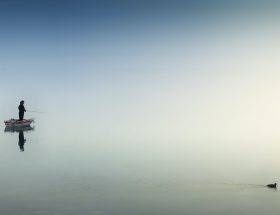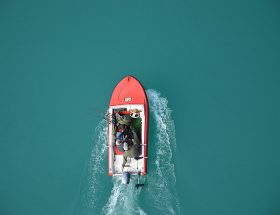This comprehensive article provides avid anglers with the ultimate guide to sports fishing. From essential gear and equipment to tips and techniques for catching a wide range of fish species, this article covers everything you need to know to take your fishing skills to the next level. Whether you’re a seasoned pro or just starting out, you’ll find valuable insights and expert advice that will help you improve your sports fishing game and land more fish than ever before.
Introduction
 Sports fishing, also known as recreational fishing, is a popular activity among anglers worldwide. It involves catching fish for sport or pleasure rather than for commercial purposes. Sports fishing can be a relaxing and enjoyable way to spend time outdoors while improving your angling skills and learning about different fish species.
Sports fishing, also known as recreational fishing, is a popular activity among anglers worldwide. It involves catching fish for sport or pleasure rather than for commercial purposes. Sports fishing can be a relaxing and enjoyable way to spend time outdoors while improving your angling skills and learning about different fish species.
Benefits of Sports Fishing
Sports fishing provides numerous benefits to anglers, including:
Stress relief: Fishing can help reduce stress and improve mental health by allowing anglers to relax and enjoy the outdoors.
Physical activity: Fishing involves physical activity such as casting, reeling, and hiking to fishing locations, which can help improve overall fitness levels.
Bonding with family and friends: Fishing can be a great way to bond with family and friends, creating lasting memories and strengthening relationships.
Learning about nature: Fishing allows anglers to learn about different fish species, habitats, and ecosystems, providing a deeper appreciation for the natural world.
Essential Gear and Equipment for Sports Fishing
Before heading out on a fishing trip, it is essential to have the right gear and equipment. Here are some of the essential items for sports fishing:
Fishing Rods and Reels
Fishing rods and reels are the most important pieces of equipment for sports fishing. A fishing rod is a long, flexible rod used to cast and retrieve fishing lines, while a fishing reel is a mechanical device used to hold and spool fishing lines.
There are several types of fishing rods and reels available, including:
Spinning Rods and Reels: These are versatile and easy to use, making them a popular choice for beginners.
Baitcasting Rods and Reels: These are designed for more experienced anglers and are used for targeting larger fish species.
Fly Fishing Rods and Reels: These are specialized equipment designed for fly fishing, which involves using artificial flies as bait.
Fishing Lines and Leaders
Fishing lines are the cords used to cast and retrieve fishing lures or bait. Fishing lines come in various materials and strengths, including monofilament, braided, and fluorocarbon lines. The choice of fishing line depends on the type of fishing and the fish species being targeted.
A fishing leader is a short section of line attached to the end of the main fishing line to provide additional strength and prevent the fish from biting through the line. Fishing leaders come in different lengths and strengths, and the choice of leader depends on the fish species being targeted and the fishing location.
Hooks, Sinkers, and Lures
Hooks, sinkers, and lures are used to attract fish to the fishing line. A fishing hook is a small, sharp metal hook used to catch fish, while a fishing sinker is a weight attached to the fishing line to help it sink.
Fishing lures are artificial baits designed to resemble natural prey, such as insects or small fish, to attract fish to the fishing line. There are different types of fishing lures, including:
Jigs: These are weighted lures with a hook on the bottom, used for bottom fishing or casting and retrieving.
Spinners: These are lures with a spinning blade that rotates when retrieved, creating a flashing and vibrating effect to attract fish.
Plugs: These are hard-bodied lures designed to resemble fish or other prey, used for casting and retrieving.
Fishing Tackle Box
A fishing tackle box is used to store and organize all the essential fishing gear and equipment, including fishing lines, hooks, sinkers, and lures. A good tackle box should have different compartments for organizing and storing the fishing gear, making it easy to access and use when needed.
Techniques for Sports Fishing
Catching fish in sports fishing requires more than just having the right gear and equipment. Here are some techniques to improve your chances of catching fish:
Casting Techniques
Casting is the act of throwing the fishing line and bait or lure into the water. Here are some casting techniques to consider:
Overhead Cast: This is the most common casting technique and involves casting the fishing line over the head, using a smooth and fluid motion.
Sidearm Cast: This technique is used when there is limited space for the overhead cast, and involves casting the fishing line to the side using a sidearm motion.
Roll Cast: This technique is used when fishing in tight spaces, and involves casting the fishing line by rolling the fishing rod and flicking the wrist to send the line forward.
Retrieving Techniques
Retrieving is the act of reeling in the fishing line with the bait or lure. Here are some retrieving techniques to consider:
Slow Retrieve: This technique involves reeling in the fishing line slowly to mimic the movement of injured prey, which can attract fish.
Fast Retrieve: This technique involves reeling in the fishing line quickly to create a buzzing or flashing effect, which can attract fish.
Stop and Go Retrieve: This technique involves reeling in the fishing line in short bursts, then pausing to let the bait or lure sink, which can attract fish.
Fish-Location Techniques
Finding fish is an essential part of sports fishing. Here are some fish-location techniques to consider:
Sight Fishing: This technique involves looking for fish in the water, either by observing their movements or by spotting them from above.
Depth Finder: This is a specialized device used to determine the depth of the water and locate fish.
Underwater Camera: This is a camera attached to a fishing line or boat that allows anglers to see underwater and locate fish.
Baiting Techniques
Baiting is the act of attaching bait to the fishing line to attract fish. Here are some baiting techniques to consider:
Live Bait: This involves using live worms, minnows, or other small creatures as bait, which can attract fish.
Artificial Bait: This involves using artificial lures or flies designed to mimic natural prey and attract fish.
Knot-Tying Techniques
Tying knots is an essential part of sports fishing. Here are some knot-tying techniques to consider:
Improved Clinch Knot: This is a simple and strong knot used to tie the fishing line to the hook or lure.
Palomar Knot: This is a strong and versatile knot used to tie the fishing line to the hook or lure.
Double Uni Knot: This is a strong and flexible knot used to tie two pieces of fishing line together.
Best Practices for Sports Fishing
Sports fishing involves more than just catching fish. Here are some best practices to consider:
Conservation and Sustainability
It is essential to practice conservation and sustainability when sports fishing to protect the environment and ensure that fish populations remain healthy. Here are some ways to practice conservation and sustainability:
Catch and Release: This involves releasing fish back into the water after catching them, rather than keeping them for consumption.
Use Barbless Hooks: Barbless hooks are easier to remove from fish, reducing the risk of injury or death.
Respect Fishing Regulations: Follow fishing regulations and rules to ensure that fish populations are not overexploited.
Safety and Responsibility
Sports fishing can be a fun and exciting activity, but it is essential to practice safety and responsibility. Here are some ways to stay safe and responsible when sports fishing:
Wear a Life Jacket: Always wear a life jacket when fishing from a boat or in deep water.
Use Sun Protection: Wear sunscreen, a hat, and sunglasses to protect your skin and eyes from the sun.
Respect Others: Be considerate of other anglers, boaters, and people in the area, and avoid overcrowding or disrupting others.
Dispose of Waste Properly: Pack out all trash and dispose of it properly, and do not leave fishing line or other gear in the water or on the shore.
Choosing the Right Location
Choosing the right location is key to a successful sports fishing trip. Here are some factors to consider when choosing a fishing location:
Type of Fish: Research the type of fish you want to catch and where they are most likely to be found.
Water Conditions: Consider the depth, temperature, and clarity of the water, as well as the presence of vegetation, rocks, and other features.
Accessibility: Consider how easy it is to access the fishing location, and whether there are any restrictions or permits required.
Local Knowledge: Talk to locals, fishing guides, and other anglers to learn about the best fishing locations and techniques in the area.
Enjoying the Experience
Finally, remember to enjoy the experience of sports fishing. Whether you catch a fish or not, spending time in nature and connecting with the environment can be a rewarding and enjoyable experience.
Conclusion
Sports fishing is a popular and enjoyable activity that requires some knowledge and skill to be successful. By choosing the right gear, learning and practicing different techniques, practicing conservation and sustainability, staying safe and responsible, choosing the right location, and enjoying the experience, you can improve your chances of catching fish and have a memorable and rewarding sports fishing trip.









